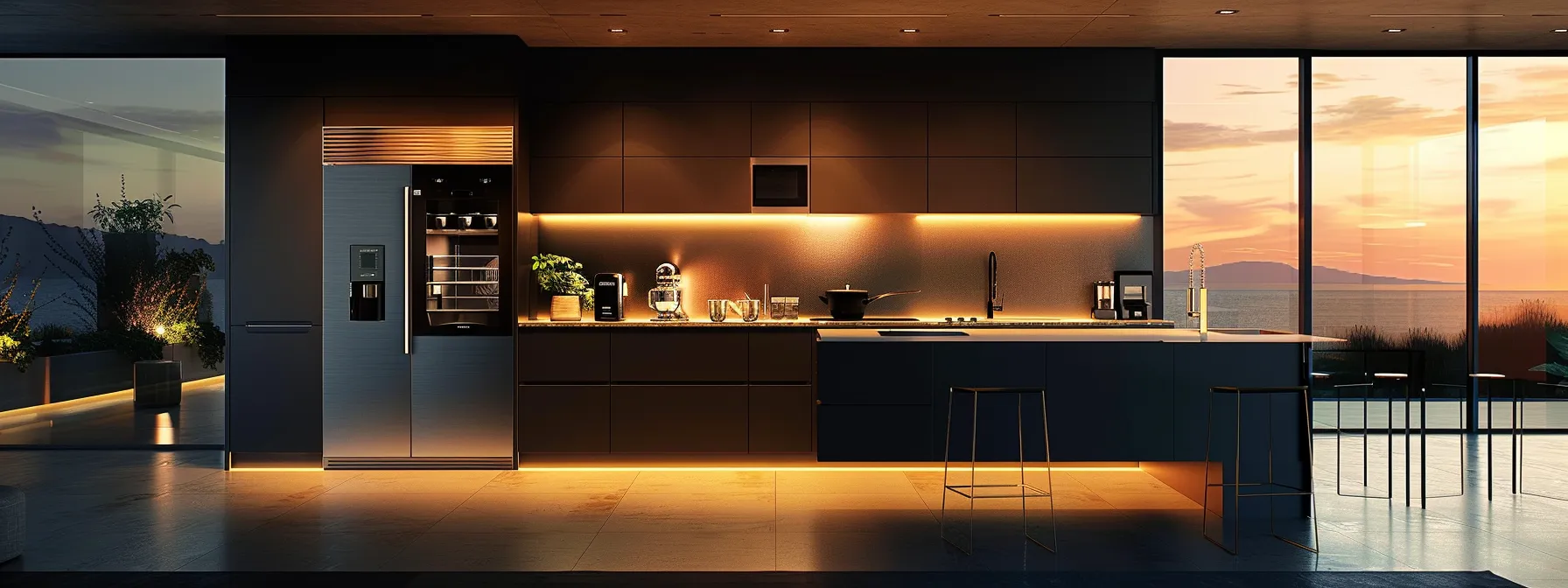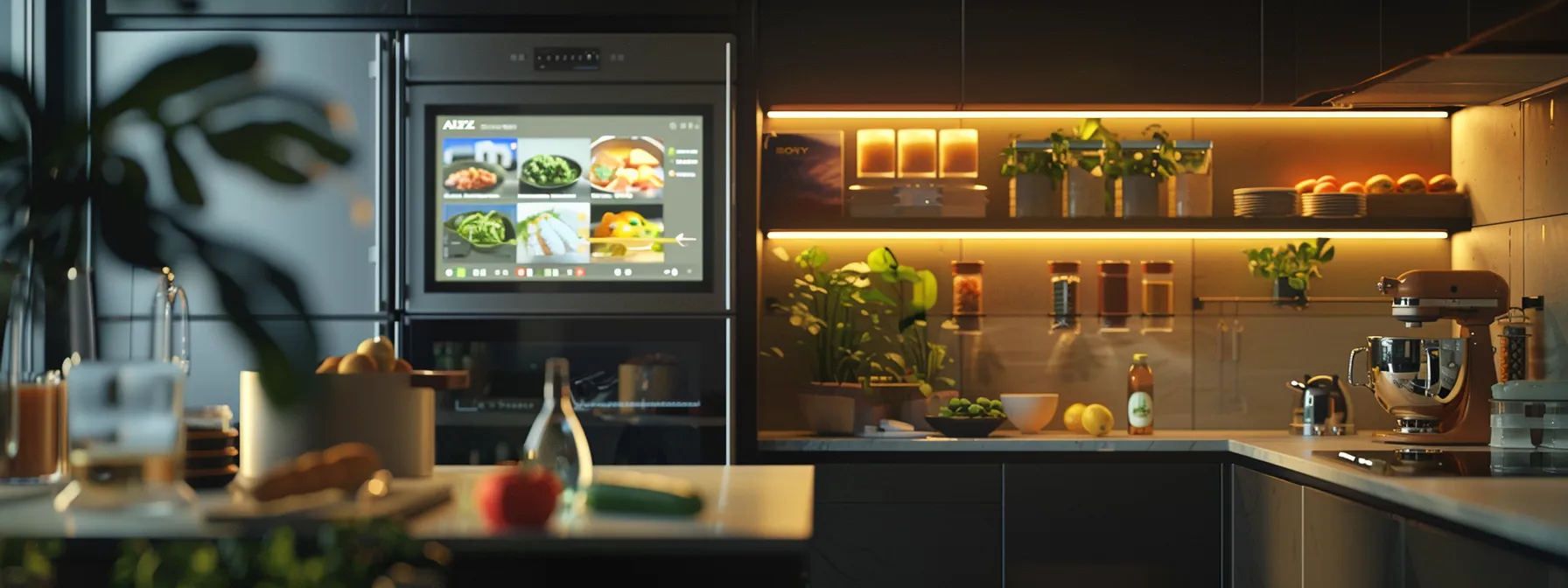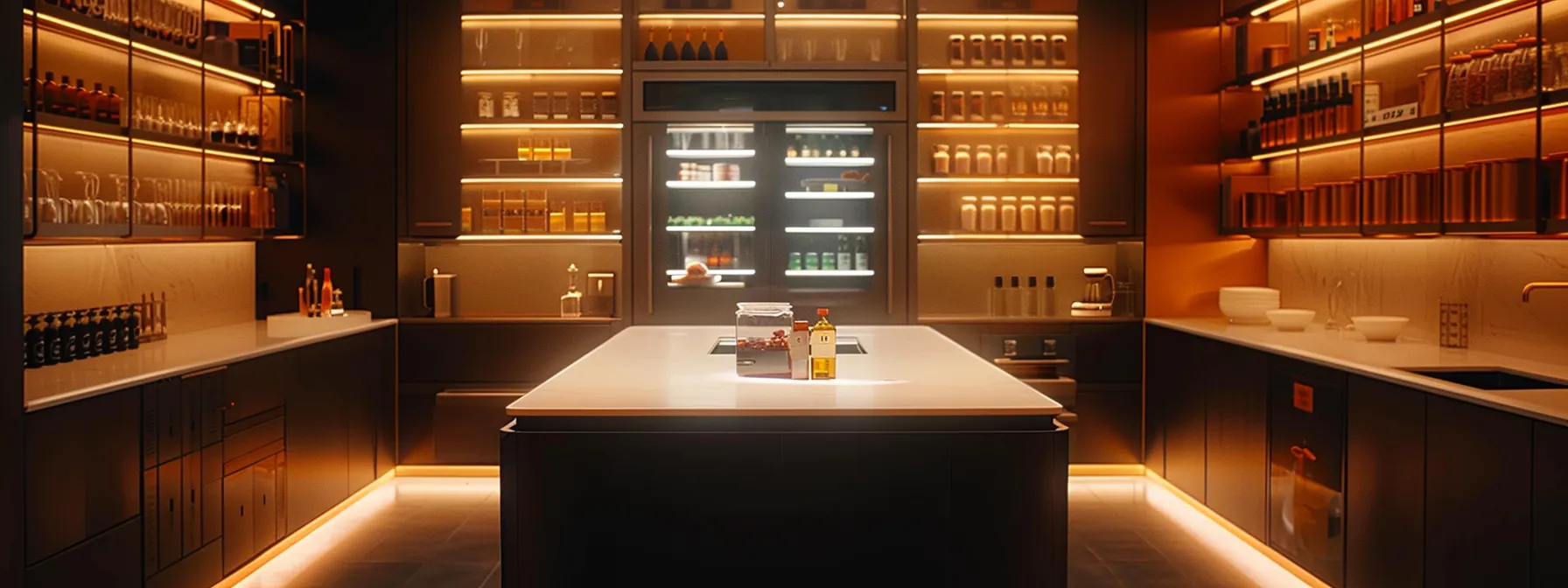

Is your kitchen keeping up with the demands of modern life? With the rise of smart technology, kitchens can become more efficient and easier to manage. This blog post will explore how smart kitchen appliances can maximize efficiency, streamline meal planning, and enhance safety. By reading on, homeowners will discover practical solutions to common kitchen challenges, making cooking more enjoyable and less time-consuming. Embrace these innovations to create a functional space that meets today’s needs and prepares for the future.

Investing in energy-efficient smart kitchen appliances can significantly enhance both food storage and cooking efficiency. Smart refrigerators retain optimal freshness, while smart ovens utilize machine learning to optimize baking times and temperatures. Programmable coffee makers ensure precise brewing routines, alongside smart dishwashers that reduce water and energy costs. Smart cooktops streamline meal preparation, and smart lighting creates an inviting ambiance, making these innovations essential for a modern kitchen.
Energy-efficient smart refrigerators offer valuable automation features that elevate food storage for both home chefs and foodservice professionals. Many modern models come equipped with remote control capabilities, allowing users to monitor and adjust temperature settings from anywhere. This ensures that perishables remain at optimal freshness, preventing waste and saving money in the long run, as highlighted by publications like Forbes.
In addition to their efficiency, smart refrigerators often include features that help users plan meals better, enabling an organized approach to food management. For example, some models provide alerts when items are nearing expiration, empowering chefs to use ingredients creatively and minimize spoilage. Embracing this technology not only simplifies meal prep but also extends the lifespan of food items, making it a smart investment for those aiming to future-proof their kitchens.
Smart ovens are revolutionizing the cooking landscape by utilizing advanced technology to optimize cooking time and temperature. These appliances connect seamlessly to the internet of things, allowing users to adjust settings remotely and monitor meals in real-time. For instance, many smart ovens feature automatic adjustments for various cooking methods, including sous vide, ensuring that each dish is prepared to perfection without constant attention.
By incorporating smart ovens into their kitchen ecosystem, home cooks can enjoy consistent results and greater flexibility in meal preparation. With built-in sensors that track cooking progress, these ovens minimize the risk of overcooking or undercooking food. This not only saves time but also enhances the overall cooking experience, allowing individuals to focus on creativity and meal enjoyment rather than worrying about precise temperatures and timing.
Programmable coffee makers, such as those offered by Haier, cater to the growing demand for convenience and sustainability in modern kitchens. These appliances allow users to customize brewing routines through mobile apps, controlling everything from brew strength to serving size. By utilizing energy-efficient technology, these coffee makers not only deliver a perfect cup but also reduce energy consumption, supporting a more sustainable household.
With the integration of advanced features, programmable coffee makers simplify morning routines and enhance the overall coffee experience. For instance, users can schedule brewing times and adjust settings remotely, ensuring their coffee is ready at the perfect moment. This level of control empowers individuals to enjoy their favorite beverages while minimizing waste and energy usage, making it a valuable addition to any tech-savvy kitchen.
Investing in smart dishwashers represents a significant step toward achieving an energy-efficient kitchen. These appliances utilize advanced technology and sensors to optimize water and energy usage effectively. For instance, many models can connect with platforms like Google Nest, allowing users to monitor and control their dishwashing cycles remotely with just the push of a button. This innovation not only reduces utility costs but also supports sustainable living practices, making it an essential component of modern kitchen design.
Smart dishwashers also address the pain point of time-consuming manual washing and drying processes. With their programmable features, users can schedule wash cycles that coincide with off-peak energy hours, further enhancing energy savings. Additionally, these dishwashers adjust settings based on the load size and soil level, ensuring that every dish, from delicate glassware to heavy roasting pans, is cleaned efficiently without wasting resources. Such thoughtful design enhances convenience while promoting a more eco-friendly lifestyle.
Smart cooktops represent a significant innovation in the culinary arts, offering advanced features that simplify meal preparation. Equipped with touchscreens, these appliances allow users to monitor cooking conditions easily and adjust settings with precision. By integrating electronics that respond to cooking needs, smart cooktops reduce the time and effort required to prepare a meal, directly addressing concerns about juggling busy schedules and rising food prices.
Every brand of smart cooktop presents unique advantages tailored to different cooking styles and preferences. Many models include programmable cooking functions that ensure dishes are prepared exactly as intended, offering a seamless experience in the kitchen. This technology not only enhances efficiency but also allows for better control over meal outcomes, ensuring that users can focus on creativity rather than worrying about the technicalities of cooking.
Integrating smart lighting into a kitchen not only enhances the overall ambiance but also improves functionality for daily tasks. For example, flexible lighting solutions can adjust brightness levels automatically based on the time of day or the specific needs of the moment, whether it’s preparing food or enjoying a meal with family. This level of customization helps customers create an inviting atmosphere while ensuring optimal visibility for countertop activities, from chopping vegetables to toasting bread in a smart toaster.
Moreover, smart lighting can work in conjunction with other kitchen appliances, enhancing their efficiency. When combined with food storage solutions, well-placed lighting can help users quickly locate items in cabinets and pantries, ensuring nothing goes to waste. By simplifying these daily routines, smart lighting not only saves time but also elevates the kitchen experience, making it a valuable addition for anyone looking to future-proof their culinary space.

Utilizing smart technology can significantly enhance meal planning in today’s kitchen. Apps streamline grocery shopping and organization, while smart kitchen scales ensure precise ingredient measurements. Recipe management software simplifies cooking, and intelligent reminders help track ingredient freshness. Exploring meal delivery options tailored to dietary needs and leveraging nutrition tracking further supports a healthy lifestyle, making these innovations essential for any modern home.
Utilizing apps for grocery shopping and meal prep organization transforms how consumers manage their kitchens with smart technology. These applications can sync with smart refrigerators, allowing users to keep track of available ingredients and receive alerts about items nearing expiration. This integration not only helps reduce food waste but also streamlines the shopping experience by creating automated grocery lists based on planned meals.
Moreover, some apps work seamlessly with cooking devices like the Instant Pot, providing users with customized recipes that match their available ingredients. By leveraging smart devices, home chefs can efficiently plan their meals, ensuring they have what they need without unnecessary purchases. This technology serves as a valuable ally, addressing common kitchen challenges and making meal planning more manageable and enjoyable for everyone.
Smart kitchen scales are revolutionizing meal preparation by providing users with accurate ingredient measurements that enhance cooking efficiency. Many models feature voice assistant compatibility, such as Amazon Alexa and Google Assistant, allowing for hands-free convenience while measuring ingredients like meat or flour. This functionality simplifies the cooking process, ensuring that users achieve precise measurements every time, which is essential for successful recipes.
Additionally, brands like Samsung Electronics have developed smart scales that integrate seamlessly with mobile apps. These apps often include recipe suggestions and nutritional information, helping users make informed decisions about their meals. By streamlining the measurement process and offering valuable cooking insights, smart kitchen scales significantly enhance the overall cooking experience, making them a must-have for modern kitchens seeking to future-proof their culinary practices.
Recipe management software serves as a powerful tool for modern kitchens, enhancing cooking efficiency and meal planning. By integrating artificial intelligence, these applications can analyze users’ preferences and suggest recipes based on available ingredients and dietary needs, making it easier to utilize a food processor or slow cooker effectively. This tailored approach not only simplifies meal preparation but also promotes healthier eating habits by managing consumption more thoughtfully.
In North America, many home cooks have turned to recipe management software to streamline their culinary processes. With built-in features like shopping lists and meal calendars, these programs help users stay organized and reduce food waste. By keeping track of ingredients and offering creative ways to use them, this technology addresses common challenges in the kitchen, ensuring that meal preparation is not just easier but also more enjoyable.
Utilizing intelligent reminders for ingredient freshness revolutionizes kitchen management by integrating with home automation systems. Users can connect their virtual assistant to appliances like smart refrigerators, ensuring they receive notifications for items nearing expiration. This proactive approach minimizes waste and encourages thoughtful meal planning, enhancing overall food inventory efficiency.
For instance, leveraging a smart microwave oven alongside these reminders allows homeowners to prepare meals based on available ingredients, while also keeping track of what’s stored in their pantry. By having a clear overview of ingredient freshness, users can create better meal schedules, reducing the likelihood of forgotten items and fostering a more organized cooking environment.
Investing in meal delivery options can significantly simplify the cooking process for those with specific dietary needs, making it easier to maintain a healthy lifestyle. Companies like LG Electronics and Whirlpool Corporation offer innovative solutions that cater to various preferences, helping customers navigate their meal planning with ease and attention to detail. These services frequently provide fresh ingredients and easy-to-follow recipes directly to consumers, allowing for a more organized approach to meal preparation without the guesswork.
Moreover, integrating meal delivery options with smart kitchen technology enhances convenience as users can efficiently plan deliveries to coincide with their cooking schedules. This seamless connection allows homeowners to maximize the potential of their kitchen appliances, such as energy-efficient dishwashers, while ensuring they have the right ingredients on hand. By leveraging this technology, individuals can better adapt to their dietary requirements, making meal prep less daunting and more enjoyable.
Nutrition tracking technology helps individuals maintain a healthy lifestyle by providing insights into their dietary choices. By leveraging algorithms integrated into smart kitchen appliances, like convection ovens and smart cooktops, users can easily monitor the nutritional content of the meals they prepare. This data aids in making informed decisions about portion sizes and ingredient selections, leading to healthier eating habits over time.
Additionally, smart nutrition tracking systems can sync with a pantry inventory, alerting users to items nearing expiration and suggesting recipes that use those ingredients. This proactive approach minimizes waste and ensures that dietary goals align with actual meal preparation. By utilizing these innovations, individuals can enjoy a more organized kitchen while effectively managing their nutrition and meal planning efforts.

Implementing smart water filtration systems can enhance health and usability in the kitchen, ensuring clean drinking water. Additionally, composting gadgets minimize food waste while solar-powered kitchen devices offer significant energy savings. Smart recycling systems help track waste reduction, while smart thermostats and energy-monitoring plugs provide insights into device usage. Each of these innovations contributes to a sustainable kitchen, making it more efficient and healthier.
Implementing smart water filtration systems can significantly enhance kitchen efficiency and promote better health. These advanced systems not only ensure access to clean drinking water but also reduce waste by minimizing the need for bottled water. Some models include features such as leak detection, helping homeowners quickly address any issues and prevent further complications, thereby maintaining the integrity of their kitchen environment.
Moreover, smart water filtration systems often integrate with overall kitchen technology, allowing for seamless management of water usage alongside heating and lighting. This connectivity empowers users to monitor their water consumption efficiently and adjust settings based on daily needs, promoting a more sustainable lifestyle. By prioritizing smart solutions, homeowners can create healthier kitchen spaces that reflect their commitment to both health and environmental responsibility.
Composting gadgets play a crucial role in minimizing food waste within modern kitchens, offering innovative solutions for eco-conscious homeowners. These devices often feature built-in motion sensors that activate when food scraps are deposited, streamlining the composting process while ensuring optimal ventilation. This efficient approach not only reduces waste but also promotes better taste in home-cooked meals, as composting enriches the soil with nutrient-dense materials for personal gardens.
By integrating composting technology with smart kitchen appliances, users can personalize their waste management experience. For instance, some models allow customization of composting speeds and methods, accommodating various preferences and kitchen setups. This level of personalization addresses the common pain point of food waste and encourages sustainable practices, transforming unwanted scraps into valuable resources for gardening or landscaping projects.
Incorporating solar-powered kitchen devices into a home is a pivotal step toward creating a sustainable kitchen. These appliances use renewable energy to cut down on electricity costs and reduce carbon footprints, allowing homeowners to enjoy energy savings while actively participating in eco-friendly practices. For instance, solar-powered cookers can harness sunlight to cook meals, enabling users to prepare food without relying on traditional power sources.
Smart recycling systems are essential tools for homeowners aiming to reduce waste in a sustainable kitchen. These systems often include features such as tracking capabilities that monitor recycling habits and provide insights on waste reduction over time. By utilizing these innovative solutions, households can identify patterns and make informed adjustments to their recycling practices, contributing to a healthier environment.
Furthermore, many smart recycling systems integrate seamlessly with mobile applications, allowing users to receive notifications about recycling schedules and tips for better waste management. This real-time information helps families stay organized and committed to their recycling efforts. As they engage with these technologies, users not only improve their waste reduction strategies but also foster a culture of sustainability within their homes:
Smart thermostats are essential for enhancing energy efficiency in the kitchen, helping homeowners manage their heating and cooling systems effectively. These devices allow users to set schedules that align with their daily routines, reducing unnecessary energy consumption when the kitchen is not in use. By utilizing features like remote access and learning algorithms, smart thermostats can adjust temperatures based on user behavior, leading to significant energy savings over time.
Moreover, the integration of smart thermostats with kitchen appliances contributes to a cohesive energy management strategy. For example, when the smart thermostat detects that the kitchen is empty, it can minimize heating or cooling, which works harmoniously with energy-efficient appliances. By adopting this technology, homeowners not only save on utility bills but also promote a sustainable living environment focused on reducing energy waste:
Incorporating energy-monitoring plugs into a kitchen can markedly enhance energy efficiency by providing insights into device usage. These smart plugs allow homeowners to track the power consumption of various appliances, ranging from blenders to refrigerators, helping them identify which devices may be using excessive energy. With this data, users can adjust their habits or consider replacing high-consumption appliances, ultimately leading to lower energy bills and a more sustainable kitchen environment.
Homeowners looking to future-proof their kitchens can greatly benefit from integrating energy-monitoring plugs with their smart devices. These plugs often feature mobile app capabilities, enabling users to monitor energy usage remotely and set schedules for devices to minimize energy consumption during peak hours. By understanding their energy patterns, individuals can make informed decisions that contribute to a greener, more efficient kitchen space, addressing both economic and environmental concerns effectively.

Ensuring safety in the kitchen is paramount to preventing accidents and promoting a secure environment. Installing smart smoke detectors provides immediate alerts, while investing in smart knives ensures safe handling during food preparation. Smart security cameras help monitor the kitchen area, and appliances with automatic shut-off features enhance safety. Additionally, implementing child-proof locks for hazardous items and using anti-slip mats with motion-sensor lights contribute to a comprehensive safety strategy that future-proofs any kitchen.
Installing smart smoke detectors is a critical step for boosting kitchen safety. These devices provide immediate alerts on potential fire hazards, allowing homeowners to respond quickly in emergencies. With features such as smartphone notifications, users can stay informed even when away from home, ensuring that safety remains a priority at all times.
Smart smoke detectors often come equipped with advanced technology that reduces false alarms, a common frustration with traditional models. By distinguishing between different types of smoke and heat, they help minimize disruptions while maintaining vigilant protection. This technology not only enhances peace of mind but also supports an overall safer kitchen environment, crucial for every household.
Investing in smart knives adds a layer of safety and precision to kitchen activities. These innovative tools often feature sensors that detect hand placement, helping to prevent accidental cuts or injuries during food preparation. By incorporating this technology, homeowners can elevate their kitchen safety and ensure a more secure cooking environment for all family members.
Additionally, smart knives may include features such as automatic retractable blades and ergonomic designs to enhance user comfort. Such advancements not only streamline the cooking process but also mitigate risks associated with handling sharp instruments. For families with children, opting for these smart kitchen tools can significantly enhance peace of mind while fostering a safe and enjoyable cooking experience:
Smart security cameras provide an effective solution for monitoring kitchen areas, enhancing safety within the home. These devices allow homeowners to keep an eye on their kitchens in real time, deterring potential intruders and ensuring that children are safe while parents are busy cooking. With features like motion detection and mobile alerts, users can receive immediate notifications of any unusual activity, providing peace of mind during meal preparation and other kitchen activities.
Incorporating smart security cameras into a kitchen can also facilitate accountability, particularly in households with older children or guests. By having the ability to review recorded footage, homeowners can ensure safe food handling practices and confirm that kitchen tasks are being performed responsibly. This proactive approach not only increases safety but also promotes a sense of security, knowing that the kitchen, a central gathering space, is monitored effectively:
Selecting appliances with automatic shut-off features is a crucial step toward enhancing safety in the kitchen. These smart devices help prevent accidents by turning themselves off after a predetermined period, ensuring that users do not have to worry about forgetting to power down appliances like ovens or stovetops. This functionality adds an essential layer of security, particularly for busy households where distractions can easily lead to oversight.
Furthermore, appliances equipped with automatic shut-off capabilities often include additional safety features, such as sensors that detect overheating or unsafe conditions. For instance, smart coffee makers will stop brewing if they sense water reservoirs are empty, preventing potential fires or damage. Integrating such technology into kitchen designs not only improves safety but also provides peace of mind, allowing homeowners to focus on the joys of cooking without constant concern for potential hazards.
Child-proof locks are essential additions to any kitchen, especially for families with young children. These locks help secure cabinets and drawers that contain hazardous items, such as cleaning supplies or sharp utensils, significantly reducing the risk of accidents. By implementing child-proof locks, parents can enjoy peace of mind knowing their little ones are safe from potential dangers while exploring the kitchen environment.
Utilizing child-proof locks presents a practical solution to common safety concerns in the kitchen. For instance, locks can be installed easily on cabinets that house knives or chemicals, ensuring that children cannot access these items. This proactive approach not only protects children but also encourages a more organized and secure cooking space, allowing families to navigate kitchen tasks confidently while prioritizing safety.
Implementing anti-slip mats in the kitchen is a vital step towards improving safety, particularly in areas that are prone to spills and moisture. These mats provide superior grip, reducing the risk of slips and falls, which can be especially hazardous when handling hot pots or sharp utensils. By choosing mats designed specifically for kitchen use, homeowners can create a secure environment that prioritizes safety while enhancing comfort during long cooking sessions.
In addition, motion-sensor lights significantly enhance visibility in the kitchen, especially at night or in low-light conditions. These lights automatically illuminate when someone enters the space, ensuring that even the busiest home cooks can navigate safely without fumbling for switches. By incorporating motion-sensor lights, families can seamlessly improve the functionality and safety of their kitchen, making it a more enjoyable place to prepare meals and gather together.

To maximize kitchen efficiency, homeowners should consider several innovative storage solutions. Choosing modular storage units can enhance cabinet space, while automated pantries simplify organization. Investing in vertical storage options saves room, and smart containers improve food preservation. Incorporating pull-out racks provides easy access to hidden cabinets, and multifunctional furniture creates compact layouts, streamlining kitchen needs.
Choosing modular storage units is essential for maximizing cabinet space in modern kitchens. These versatile solutions allow homeowners to customize their storage needs, taking advantage of every inch available. By implementing modular systems, individuals can easily reorganize and adapt their kitchen layout as their appliance needs change, ensuring that they always have a functional and efficient space.
Modular storage options simplify organization by providing designated areas for pots, pans, and other culinary essentials. This personal approach not only reduces clutter but also enhances access to frequently used items, making meal preparation easier and more efficient. With the right modular units, homeowners can future-proof their kitchens, promoting a smarter, well-planned environment that caters to changing lifestyles and preferences.
Automated pantries represent a significant advancement in kitchen organization, simplifying the way homeowners manage their food supplies. Equipped with technology that tracks inventory levels, these smart systems alert users when items are running low or nearing expiration, helping to reduce waste and ensure that the kitchen remains well-stocked. This feature not only enhances efficiency but also supports meal planning by allowing individuals to easily locate and access ingredients when needed.
By integrating automated pantry solutions with mobile applications, users can enjoy a seamless kitchen experience. These technologies offer customizable settings, enabling homeowners to create an organized space that reflects their cooking habits and preferences. For instance, some systems may suggest recipes based on available ingredients or display shopping lists, making the overall purchasing experience straightforward and efficient:
Investing in vertical storage options is crucial for creating an efficient kitchen space. By utilizing walls and vertical surfaces, homeowners can free up valuable counter and floor space, making the kitchen feel larger and more organized. This approach not only enhances accessibility to frequently used items but also promotes a streamlined cooking experience, allowing individuals to focus more on meal preparation rather than searching for pots, pans, or kitchen gadgets.
Innovative shelving units and hanging racks are perfect examples of vertical storage solutions that maximize space. These systems allow for the safe display of cookware, spices, and utensils while keeping them within easy reach. Implementing such solutions can lead to a more functional kitchen, helping homeowners to maintain order and efficiency in their culinary activities while also contributing to a visually appealing kitchen design.
Smart containers have transformed food preservation by utilizing advanced technology to maintain optimal freshness. These innovative solutions often feature built-in sensors that monitor humidity and temperature, allowing users to create the ideal environment for various food items. By extending the shelf life of perishable goods, smart containers significantly reduce food waste, helping homeowners save money while contributing to a more sustainable lifestyle.
Incorporating smart containers into the kitchen not only enhances food storage but also streamlines meal prep. Some models connect to mobile apps, providing alerts when items are nearing expiration and offering recipe suggestions based on available ingredients. This functionality empowers users to make informed choices about their meals, effectively reducing last-minute grocery runs and promoting a more organized and efficient kitchen experience.
Incorporating pull-out racks into kitchen cabinets can significantly enhance accessibility and organization, addressing common storage challenges. These racks allow homeowners to easily retrieve items that might otherwise be hard to reach, maximizing the use of deep cabinets. By effectively utilizing this smart storage solution, individuals can streamline their meal prep and ensure that every tool and ingredient is readily accessible when needed.
Furthermore, pull-out racks are adaptable to various kitchen designs and can be customized to fit different storage needs. For example, they can be installed for spices, pots, or even pantry items, eliminating clutter and promoting efficient use of space. Homeowners looking to future-proof their kitchens will find that these innovative solutions not only improve functionality but also contribute to a visually organized environment:
Leveraging multifunctional furniture is an effective way to maximize space in modern kitchens, especially for homeowners with compact layouts. Options such as kitchen islands that double as dining tables or storage units can enhance utility while providing a seamless design. These versatile pieces allow for organized cooking and dining areas, making them essential for homeowners looking to future-proof their kitchens.
Incorporating multifunctional furniture not only addresses space limitations but also contributes to a more efficient cooking experience. For example, a foldable table can create additional workspace during meal prep and conveniently tuck away when not in use. This adaptability ensures a functional kitchen setting where every inch counts, allowing homeowners to enjoy both comfort and practicality in their culinary environment.

Integrating voice assistants enables hands-free control of kitchen appliances, enhancing convenience. Syncing devices promotes seamless operation and timely alerts, while smart hubs allow management of multiple devices simultaneously. Connecting security and outdoor cameras increases safety, and smart sensors track energy usage effectively. Finally, app-controlled thermostats ensure precise temperature adjustments, optimizing the kitchen environment for both comfort and efficiency.
Integrating voice assistants in the kitchen allows homeowners to control appliances with ease, making cooking and meal preparation more efficient. For instance, by simply asking a voice assistant to set a timer or adjust the oven temperature, users can multitask effectively without the need to touch their devices. This hands-free approach not only improves convenience but also enhances safety by minimizing distractions while cooking.
Furthermore, voice assistants can sync with smart kitchen ecosystems to provide real-time updates and alerts. Homeowners can ask their devices about upcoming tasks, receive reminders to check on cooking meals, or even inventory alerts from smart refrigerators. This feature addresses common frustrations in the kitchen, offering solutions that streamline daily tasks and create a more enjoyable culinary experience.
Syncing appliances within a smart kitchen ecosystem significantly enhances operational efficiency and user convenience. By integrating devices such as smart refrigerators, ovens, and dishwashers, homeowners gain the advantage of coordinated functionality, allowing them to control multiple appliances from a single interface. This streamlined approach not only saves time but also provides real-time alerts, ensuring that users are informed about meal progress and appliance status at all times.
For instance, when a smart oven is preheating, a connected coffee maker can be programmed to start brewing at the perfect time, thus aligning cooking and beverage preparation seamlessly. This efficient synchronization reduces the potential for interruptions and creates a smoother cooking experience, which is essential for busy households. By employing smart technology to connect appliances, individuals can maximize their kitchen’s potential and future-proof their cooking space with ease.
Smart hubs serve as the central command centers for coordinating various kitchen appliances, enabling homeowners to manage their smart environments more efficiently. By integrating devices like smart ovens, refrigerators, and dishwashers into a single system, users can control functionalities from one interface, making daily tasks simpler. This centralized management reduces the time spent navigating between apps and settings, ensuring that everything operates harmoniously and effectively in the kitchen.
Choosing the right smart hub can significantly enhance a kitchen’s overall efficiency. For example, when a smart oven is preheating, the hub can automatically adjust the settings of connected appliances, such as starting a coffee maker or managing lighting for the perfect cooking environment. This level of synergy not only streamlines meal preparation but also allows homeowners to focus on creativity and cooking, ultimately modernizing their kitchen experience with the latest smart technology.
Connecting security and outdoor cameras to a kitchen not only enhances safety but also integrates seamlessly into a smart home ecosystem. Homeowners can monitor their kitchen areas and surroundings in real-time, providing peace of mind when preparing meals. By receiving alerts on mobile devices, they can respond promptly to any unusual activity, ensuring that their culinary space remains secure and protected.
Moreover, modern security cameras often feature night vision and smart technology that can distinguish between people and pets. This capability minimizes unnecessary alerts, allowing homeowners to focus on cooking without distractions. As part of a future-proof kitchen, integrating these security solutions enhances both safety and functionality, addressing common concerns about kitchen security:
Incorporating smart sensors for energy usage tracking in the kitchen is a practical way to promote efficiency and sustainability. These sensors monitor the power consumption of various appliances, providing homeowners with real-time data on their energy use. By identifying which devices consume the most energy, individuals can make informed decisions about their cooking habits and appliance upgrades, resulting in cost savings and a reduced carbon footprint.
These sensors integrate seamlessly into smart home ecosystems, connecting with other devices for enhanced control. For example, users can set alerts for appliances that exceed designated energy thresholds, prompting timely adjustments to usage. This proactive approach to energy management not only helps to lower utility bills but also contributes to a smarter and more responsible kitchen environment.
App-controlled thermostats offer a convenient solution for homeowners looking to optimize temperature settings in their kitchens, directly contributing to a more energy-efficient environment. These smart devices enable users to make precise adjustments from anywhere, ensuring that the kitchen remains comfortable while cooking or during gatherings. By leveraging real-time data and user preferences, app-controlled thermostats help streamline energy consumption, leading to reduced utility bills and a lower carbon footprint.
Moreover, integrating app-controlled thermostats within a smart home ecosystem enhances overall kitchen functionality. Homeowners can establish tailored schedules that adjust temperatures based on their daily routines, ensuring the kitchen is at the ideal temperature when it’s time to cook. This level of control not only boosts comfort but also supports the efficient use of other smart kitchen appliances, making it a valuable investment for those aiming to future-proof their culinary spaces.
Future-proofing a kitchen with smart technology is essential for enhancing efficiency, sustainability, and safety in modern homes. Investing in smart appliances, from energy-efficient refrigerators to programmable coffee makers, not only simplifies meal preparation but also reduces waste and utility costs. Embracing these innovations enables homeowners to create organized, healthy culinary environments that adapt to their changing needs. By integrating smart solutions, one can transform the kitchen into a functional space that stands the test of time and meets the demands of today’s lifestyle.
